blog

DD v. YouTube at the Fifth Circuit
December 16, 2025

Last week YouTube noticed an appeal of Judge Albright’s surprise denial of their motion to transfer our case to California. We quickly filed a motion to dismiss with the Fifth Circuit, which you can read below:
I like that Google’s very best authority for their appeal is Defense Distributed v. Bruck, a case longtime LEGIO members will recognize.
As a follow-up to this move, yesterday we filed a motion encouraging Judge Albright to remand our case against YouTube to a Texas state court — where YouTube will surely die.
Merry Christmas. If you would like to support our legal actions, please join LEGIO.
DD v. YouTube – Transfer Denied
November 17, 2025

Last week in Defense Distributed v. YouTube (1:25-cv-01095-ADA), after Judge Albright surprised Team Google with a dramatic motions hearing, YouTube’s motion to transfer was denied. You’re welcome to read that hearing’s transcript.
Google’s attempt to transfer our case to California failed. And this failure is the first endorsement of the new reading the law’s framers have given Texas’ HB20 after NetChoice. Our case will stay in Texas, and HB20’s powers (and penalties) against YouTube will be construed by a Texas court.
This is not good news for San Francisco. This is not good news for the District of Columbia. The denial follows:
If you would like to support our legal actions, please join LEGIO.
DD v. YouTube Hearing
October 23, 2025
Two interesting developments in Defense Distributed v. YouTube (1:25-CV-01095-ADA, W.D. Tex.), the state court case Google couldn’t help but bring into the federal system:
1. Judge Albright, a Trump appointee, snatched the case up from the magistrate sua sponte.
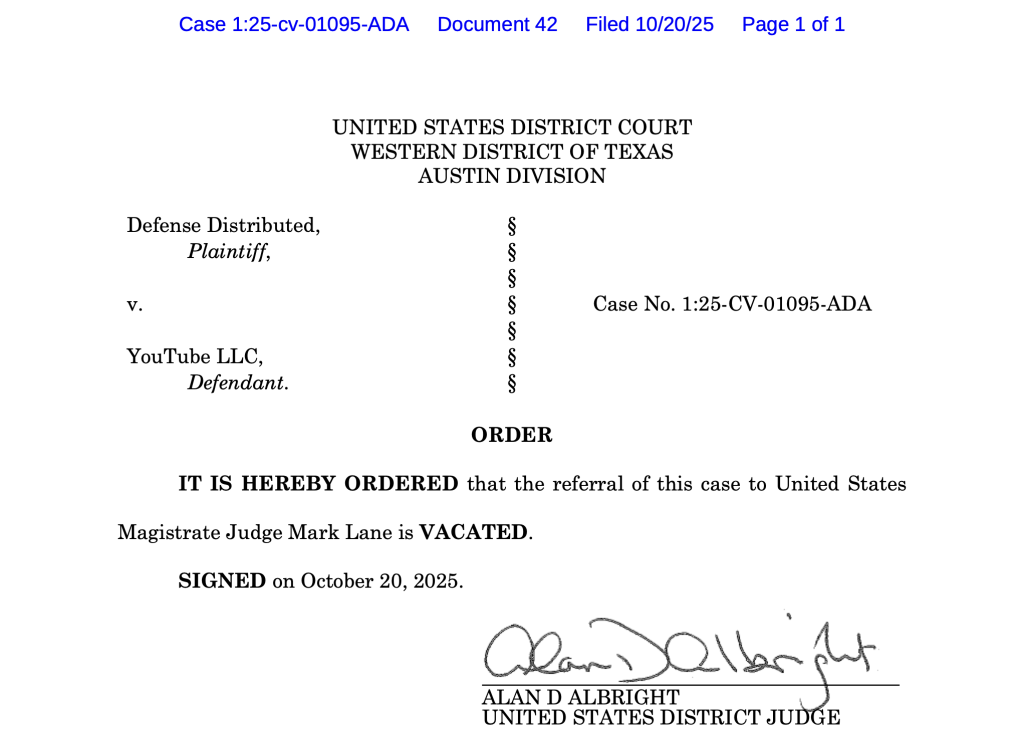
2. Judge Albright has set a hearing, one week from today, concerning Defense Distributed and Google’s cross motions to remand or transfer the case, making this the first proper showdown concerning Texas’ recent changes to HB20. More attention given to this case is good. The hearing details are below.
Hearings are more fun in person than over Zoom, but we’ll get to announce one of those in another case soon.
If you would like to support our legal actions, please join LEGIO.
What Happened to FOSSCAD?
September 29, 2025
No (primal) father should have to bury his (disabled) child. The young perish while the old linger. Alas, that these evil days should be mine!
Yes, the FOSSCAD subreddit was banned on Friday, September 26th for violating “Rule 7.” Among others, I have been scapegoated because I mentioned FOSSCAD in a federal lawsuit filed the previous day against the John Elik Gang. I will say in my defense, however, that this was, to use a soft ontological term The Gatalog will understand, a rifle pleading. I therefore doubt it had too large a spread online before the very next day. Note: Though rifle pleading is my coinage and I give it away for free, I will sue you if you steal it.
There’s talk of new “communities,” a forum, or of moving to new tech like Fediverse (Freeman1337 has moved here already). But you’ll find Redditors stick to Reddit.
What is Rule 7? Does it matter? To duke themselves in on the meager profits made from 3D2A kits, FOSSCAD and The Gatalog pursued a strategy of deliberate ignorance of the law and public policy of 3D guns. As the social rituals began to fail and we entered a sacrificial crisis, the strategy evolved to one of denial and, ultimately, perverse disavowal.
What does this letter mean? Won’t anyone Fuddbust its funny numbers?
You might think to ask the Oracle at Alton. Nothing he couldn’t see coming. But I wouldn’t expect a two hour YouTube video anytime soon. Soft ontologies are good, actually! Better to understand the above letter as a ticket to a rough ride. Better to understand it as one of the as yet unexplored consequences of the death of the author.
To FOSSCAD and the Oracle I devote a new copyrightable work, which was written to be chanted to the tenth movement of Arvo Pärt’s Lamentate.
Mournful that day
When my most passionate flatterer,
for a survival rifle,
marched out his army of retards to die.
O, Ivan!
Ivan Agonistes!
If you would like to support our legal actions, please join LEGIO.
Defense Distributed v. Bondi
July 14, 2025
On Friday Defense Distributed filed our reply to the ATF’s objection to our motion for an injunction against the Biden/Trump “frame or receiver” rule. It’s a Trump rule now not just because his DOJ defends it, but because it gives the rule novel interpretations never attempted in the Biden years.
This filing was more enjoyable to prepare than usual because of the excuse to engage with the “history and tradition” of privately made arms demanded by Bruen. We work into the record two surveys of industrial history that became my favorites after Defense Distributed’s failed effort to sue California back in 2022. They are provided below.
This reply was also enjoyable for the chance to respond to ATF’s candid admission that their rule “modestly impinges” Second Amendment rights. The Bondi DOJ may soon realize this statement was worse than an infelicity.

Those two industrial histories for you. David Hounshell’s From the American System to Mass Production, 1800-1932 and Conservative Innovators and Military Small Arms: an Industrial History of the Springfield Armory, 1794-1968. You can’t find an historical, industrial analogue for the regulation of the private production of small arms in America because it was that very history of private production that built the American System in the first place.
You can support our legal work by joining LEGIO.
Independence Day SITREP
July 3, 2025
Just in time to celebrate that civil war we won in the 1770s to reject Hanoverian imperialism, NPR warns us that ghost guns may not be so dead. They may even be doing that whole revenant thing which, in fairness, ghosts are known to do.
Just a word about the two legal strategies reported above. SAF and Gottlieb have elected to take Trump and Bondi at their word that the administration will most likely eliminate the Biden “frame or receiver” rule with which we’ve contended since 2021. This is not an insane strategy.
But the Defense Distributed strategy was and is to see what the Trump DOJ would do about this rule in federal court, since actions are much stronger signals than task forces and talk. And what the Trump DOJ has signaled to O’Connor about the frame and receiver rule is not good:
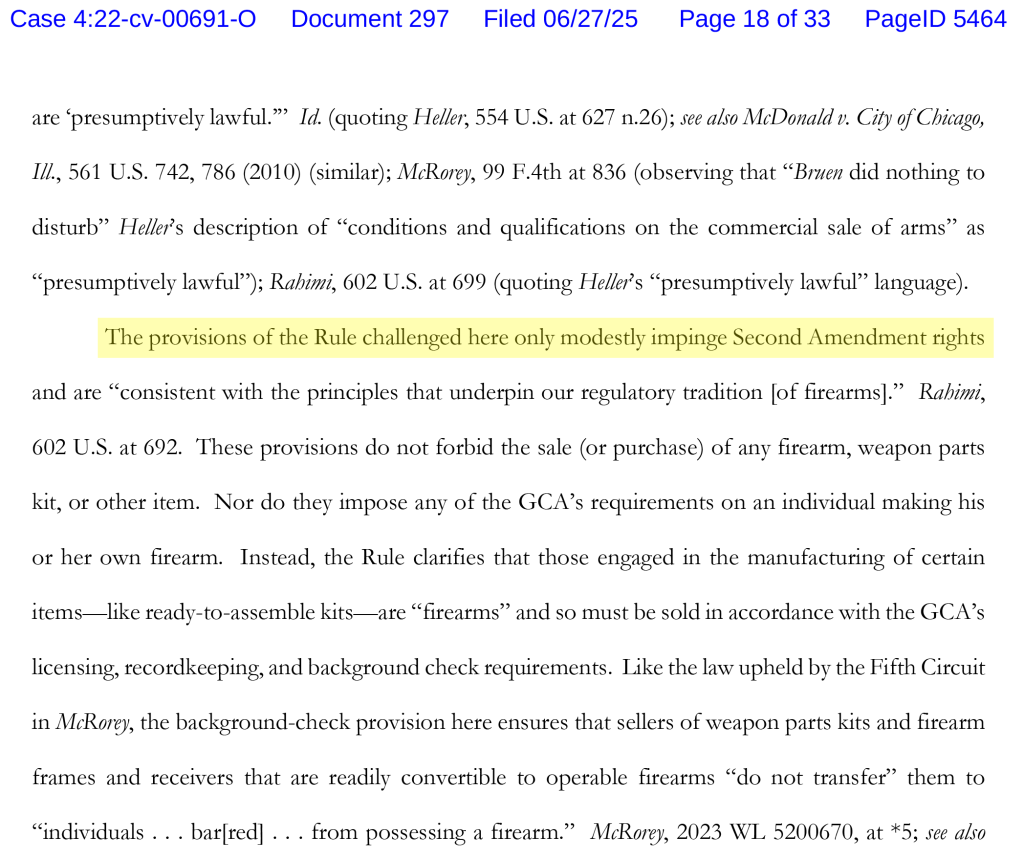
Did you catch that? In Bondiland, the Second Amendment isn’t infringed if it’s impinged. Read it yourself.
In my experience, such outrageous trash can only be compared to Judge Lasnick’s 2018 declaration that any First Amendment right of 3D gun printers “is currently abridged, but has not been abrogated.”
A reminder this Fourth that gun violence trumps verbalism. The Second Amendment enshrines this political recourse.
You can support our legal work by joining LEGIO.
DD-Day
June 9, 2025
Last Friday Defense Distributed made its first filings in the aftermath of the Supreme Court’s VanDerStok decision. Unlike the case’s other plaintiffs, we’ve maintained fully briefed Second and Fifth Amendment arguments that can now have their day. AG Bondi and the Trump DOJ asked for a sixty (60) day stay to evaluate their (love for the) ATF receiver rule. Sixty days to determine the meaning of “shall not be infringed.” It doesn’t work like that, guys. We’re going to need a decision that the Second Amendment includes the necessary right to make firearms.
This new front in an old action may be restyled as Defense Distributed v. Bondi. You can read our brief and exhibits here:
Another consequence of VanDerStok is the accelerated censorship of online speech concerning firearms. Though state laws like Texas’ HB20 have afforded firearms “influencers” years of opportunities to combat the rampant censorship and de-platforming on social media sites like YouTube, it’s telling that they’ve all so far remained asleep in their symbolic bedrooms. On Friday we filed another action in a Texas state court named Defense Distributed v. YouTube.
Why do this? Isn’t YouTube just emotional theater for “Guntubers” and gear queers? Wouldn’t it rather advance the fight for the Second Amendment to let Google crush these people’s fragile imaginary (over)identifications?
I agree these sites are places to flee from The Real. Only on YouTube might a doomstruck “rat” and his Samoan attorney, for example, nurse along the fiction that they’re sophisticated litigators. In the dream logic of YouTube, if you post a long enough string of trivial shotgun content, the earth stays solid and JStark buried in it. Myanmar and Mangione remain phantasmatic images from *out there* that can never enter to shatter your reality. As your attorney, I advise you to post more tedious AR-15 videos.
But what if in our video dreams, which we construct as an escape, we encounter a trauma more horrifying than any reality? Could the real trauma be from the excess of our dreams? Could our fictions become so traumatic that they awaken us into reality?
This is the bet I’m willing to make by suing YouTube. Now here’s a video of a general wandering the Desert of The Real.
You can support our legal work by joining LEGIO.
Trump’s DOJ and G80 Receivers
May 20, 2025
On Friday the Trump DOJ announced a settlement with Rare Breed Triggers, which in a significant way ends the public battle over Forced Reset Triggers (FRTs). This was broadcast by our government as a win for the Second Amendment:
My opinion of this outcome is biased by our own (ongoing) DOJ settlement conversations in what’s left of the “frame and receiver” case before Judge O’Connor in Texas. Readers will note O’Connor was also the presiding judge in the FRT case.
The sticking point in our conversations has been the G80 System, which represents the fulfillment of Justice Gorsuch’s brave new vision and, therefore, the next generation of 80 percent firearms. Trump’s DOJ disfavors a G80 settlement because the system is, unlike FRTs, emphatically open source. Without enforceable IP, these government lawyers will have no way of pointing to our settlement’s simultaneous enhancement of “pubic safety” (read: gun control). In summary, a G80 settlement would require team Trump to admit the true consequences of a Supreme Court decision that they had plenty of time to avoid.
I make this post to announce to LEGIO members the next leg of Defense Distributed’s public development of ghost gun technology. We are now in our third run of production, which is exclusively reserved for supporting members of Defense Distributed. Your membership brought us to, and now through, the United States Supreme Court. LEGIO members are also welcome to contact our sales team regarding dealer opportunities.
It goes without saying, but G80 sales will fund our renewed litigation against AG Bondi, who for whatever reason insists upon limiting The People’s right to keep and bear arms.
You can support our legal work by joining LEGIO.
On Raids and Raiding
April 22, 2025
Last week ATF raided and arrested the moderators of a Discord server connected to the interstate development and sale of 3D NFA items. Though one of these moderators may have been a confidential informant, word is the raids were simply the result of an(other) anonymous tip.
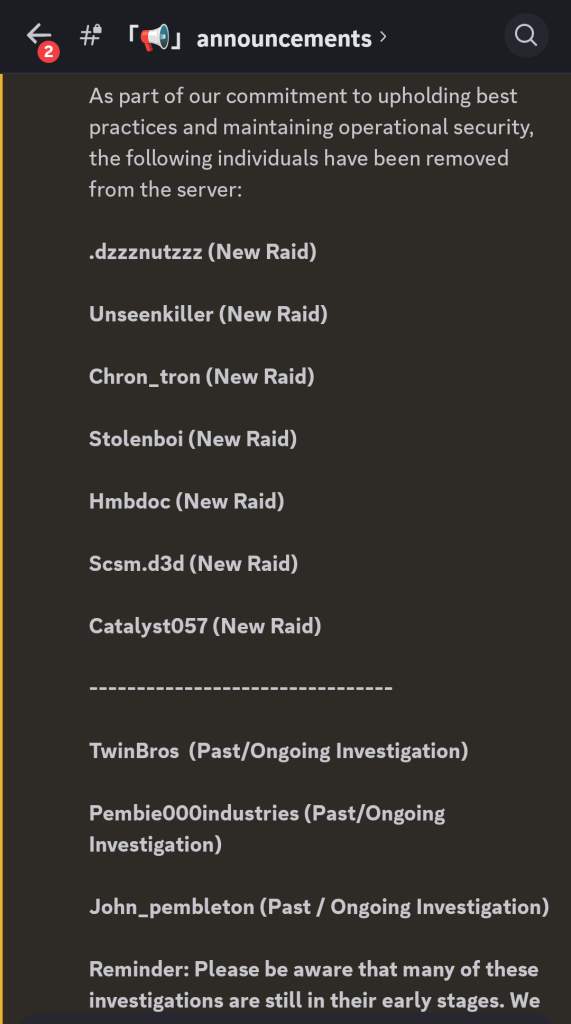
When a journalist asked me if this is the first major raid of a 3D gun community, I said I could understand why he’d believe it was. Guncad’s folkways privilege repeated forgetting, denial, and perverse disavowal.
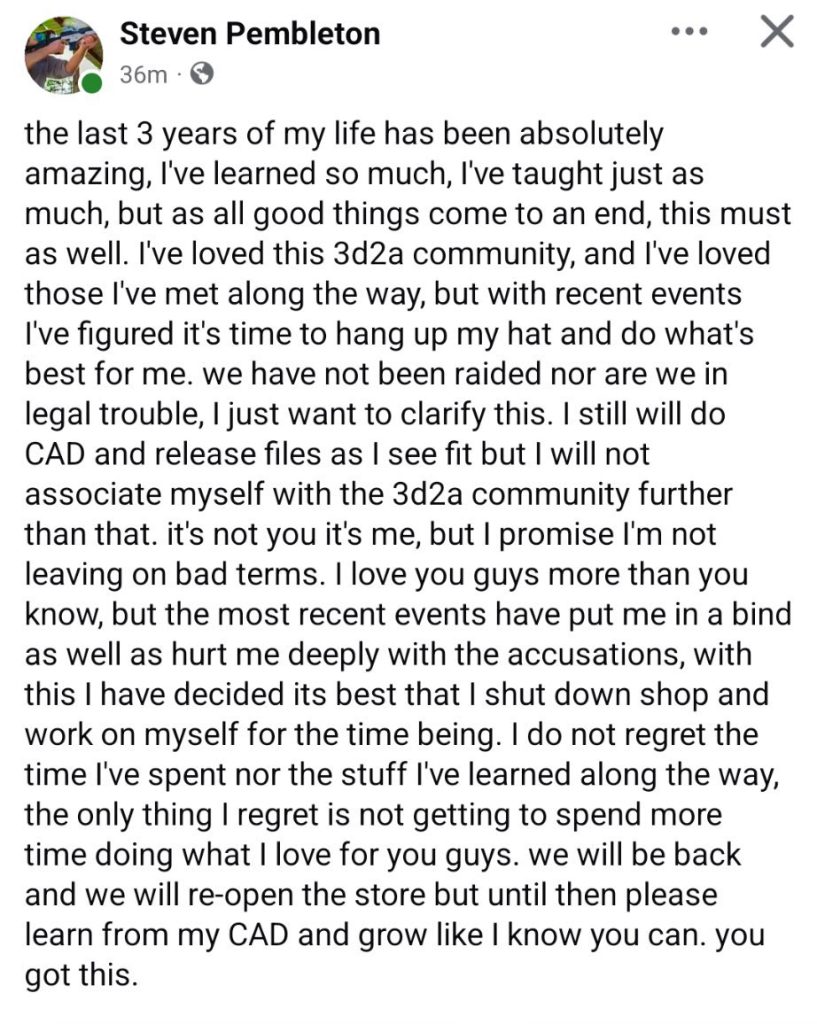
As if this is the first time this guy has written this. So Steven is leaving, just not really leaving, because of recent events, but not because of those events, and on the best of terms, though he’s “hurt deeply.”
We’re dealing with a mode of knowledge and its deployment that de-realizes. Just last year The Gatalog suffered a sensational raid so complete and compromising that Alex Holladay employs his knowledge of it to, paradoxically, disavow its entire reality. Biannually.
Sage counsel from the space’s most prodigious poster of felonies, offered in that spirit of detachment and courtesy for which The Gatalog has become so known. It’s as if simple kennings like “felony-poster” or “fudd-buster” alone could protect the gang from the much larger ATF investigation of their own server.
Reading Holladay, we see the knowledge of his trauma isn’t something to be disavowed. He instead recruits it to help him publicly disavow the real of that same knowledge. The structure works something like this: “We know very well that The Gatalog’s beta rooms have been dumped, and that users like UberClay are identified, and that’s why we can forget about it.”
You can support our legal work by joining LEGIO.
All Fools’ Day
April 1, 2025
Reason has two excellent pieces on the takeaways from Bondi v. VanDerStok. Today’s is a survey of the judicial cowardice of the Court’s “Salerno rule” by professor Josh Blackman, a Defense Distributed attorney.
The Salerno rule was how Judge Sutton of the Sixth Circuit saved Obamacare’s individual mandate back in 2011. It featured in Justice Breyer’s dissent in McDonald as his preferred method to deny gun rights in the name of safety. “The Court may have overruled Chevron, but it has just inadvertently created a far more powerful deference doctrine with Salerno, all in service of narrowly reversing the Fifth Circuit.” Thus Blackman.
Journalists point out this was a 7-2 decision, but if you read Alito closely he’s not disagreeing with the result. The Supreme Court is 8-1 against DIY guns. Gorsuch expects the plaintiffs and the public to swallow this nonsense “artifact noun” discussion, and to accept his glib assessment that we were unprepared to properly challenge the Biden ghost gun rule. I refuse.
Court decisions are also artifacts made by all-too-human hands. In my judgment, the Supreme Court was the only party ill-prepared to make its case. See the metadata in Gorsuch’s “I know it when I see it” Polymer80 photos:
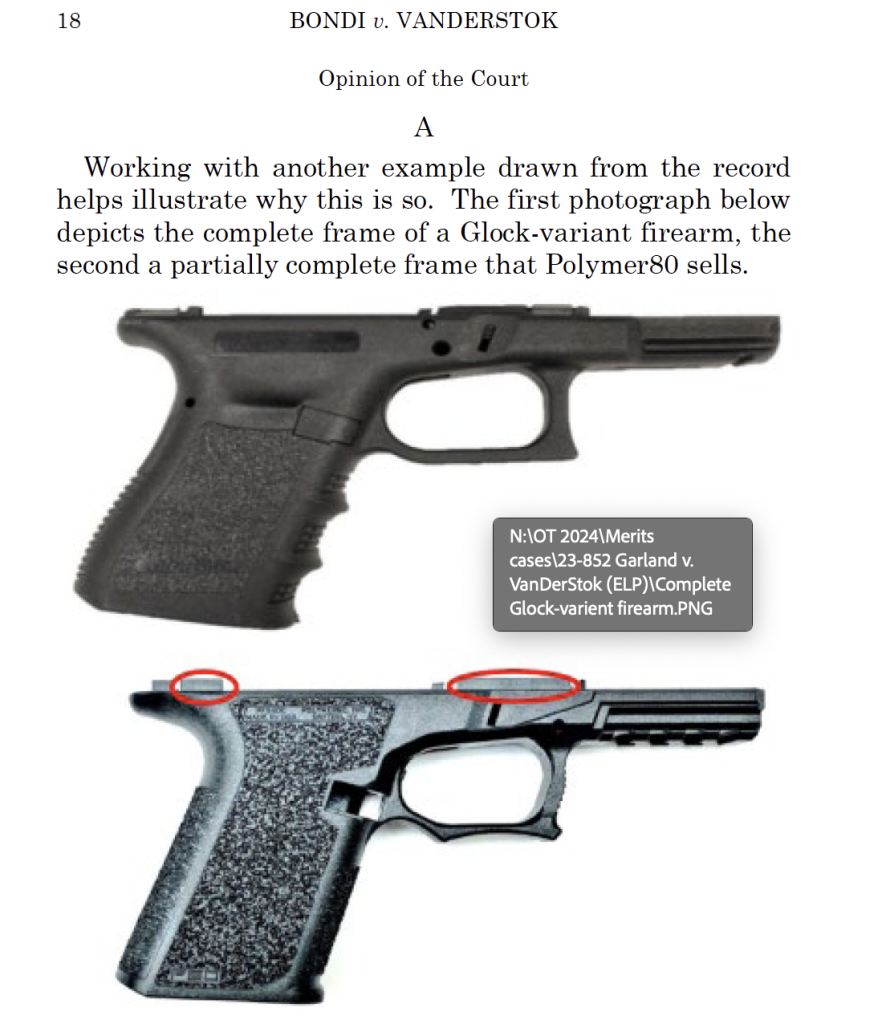
You think any Gorsuch clerks might have the initials ELP? It will be a fools’ errand cleaning that off the Internet.
You can support our legal work by joining LEGIO.